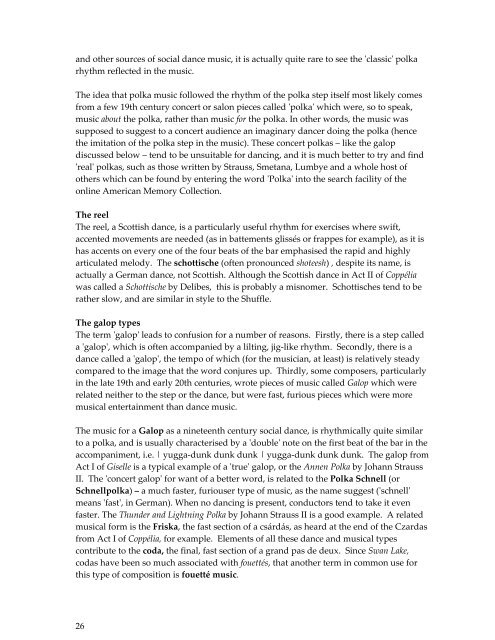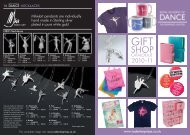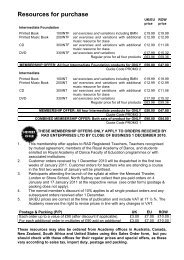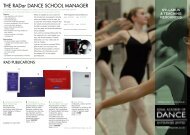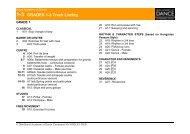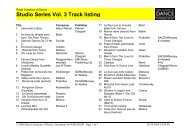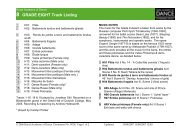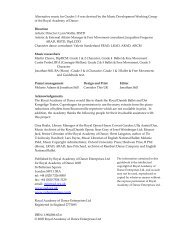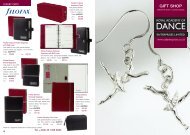to download the guide book in - Royal Academy of Dance Enterprises
to download the guide book in - Royal Academy of Dance Enterprises
to download the guide book in - Royal Academy of Dance Enterprises
Create successful ePaper yourself
Turn your PDF publications into a flip-book with our unique Google optimized e-Paper software.
and o<strong>the</strong>r sources <strong>of</strong> social dance music, it is actually quite rare <strong>to</strong> see <strong>the</strong> ʹclassicʹ polka<br />
rhythm reflected <strong>in</strong> <strong>the</strong> music.<br />
The idea that polka music followed <strong>the</strong> rhythm <strong>of</strong> <strong>the</strong> polka step itself most likely comes<br />
from a few 19th century concert or salon pieces called ʹpolkaʹ which were, so <strong>to</strong> speak,<br />
music about <strong>the</strong> polka, ra<strong>the</strong>r than music for <strong>the</strong> polka. In o<strong>the</strong>r words, <strong>the</strong> music was<br />
supposed <strong>to</strong> suggest <strong>to</strong> a concert audience an imag<strong>in</strong>ary dancer do<strong>in</strong>g <strong>the</strong> polka (hence<br />
<strong>the</strong> imitation <strong>of</strong> <strong>the</strong> polka step <strong>in</strong> <strong>the</strong> music). These concert polkas – like <strong>the</strong> galop<br />
discussed below – tend <strong>to</strong> be unsuitable for danc<strong>in</strong>g, and it is much better <strong>to</strong> try and f<strong>in</strong>d<br />
ʹrealʹ polkas, such as those written by Strauss, Smetana, Lumbye and a whole host <strong>of</strong><br />
o<strong>the</strong>rs which can be found by enter<strong>in</strong>g <strong>the</strong> word ʹPolkaʹ <strong>in</strong><strong>to</strong> <strong>the</strong> search facility <strong>of</strong> <strong>the</strong><br />
onl<strong>in</strong>e American Memory Collection.<br />
The reel<br />
The reel, a Scottish dance, is a particularly useful rhythm for exercises where swift,<br />
accented movements are needed (as <strong>in</strong> battements glissés or frappes for example), as it is<br />
has accents on every one <strong>of</strong> <strong>the</strong> four beats <strong>of</strong> <strong>the</strong> bar emphasised <strong>the</strong> rapid and highly<br />
articulated melody. The schottische (<strong>of</strong>ten pronounced shoteesh) , despite its name, is<br />
actually a German dance, not Scottish. Although <strong>the</strong> Scottish dance <strong>in</strong> Act II <strong>of</strong> Coppélia<br />
was called a Schottische by Delibes, this is probably a misnomer. Schottisches tend <strong>to</strong> be<br />
ra<strong>the</strong>r slow, and are similar <strong>in</strong> style <strong>to</strong> <strong>the</strong> Shuffle.<br />
The galop types<br />
The term ʹgalopʹ leads <strong>to</strong> confusion for a number <strong>of</strong> reasons. Firstly, <strong>the</strong>re is a step called<br />
a ʹgalopʹ, which is <strong>of</strong>ten accompanied by a lilt<strong>in</strong>g, jig‐like rhythm. Secondly, <strong>the</strong>re is a<br />
dance called a ʹgalopʹ, <strong>the</strong> tempo <strong>of</strong> which (for <strong>the</strong> musician, at least) is relatively steady<br />
compared <strong>to</strong> <strong>the</strong> image that <strong>the</strong> word conjures up. Thirdly, some composers, particularly<br />
<strong>in</strong> <strong>the</strong> late 19th and early 20th centuries, wrote pieces <strong>of</strong> music called Galop which were<br />
related nei<strong>the</strong>r <strong>to</strong> <strong>the</strong> step or <strong>the</strong> dance, but were fast, furious pieces which were more<br />
musical enterta<strong>in</strong>ment than dance music.<br />
The music for a Galop as a n<strong>in</strong>eteenth century social dance, is rhythmically quite similar<br />
<strong>to</strong> a polka, and is usually characterised by a ʹdoubleʹ note on <strong>the</strong> first beat <strong>of</strong> <strong>the</strong> bar <strong>in</strong> <strong>the</strong><br />
accompaniment, i.e. | yugga‐dunk dunk dunk | yugga‐dunk dunk dunk. The galop from<br />
Act I <strong>of</strong> Giselle is a typical example <strong>of</strong> a ʹtrueʹ galop, or <strong>the</strong> Annen Polka by Johann Strauss<br />
II. The ʹconcert galopʹ for want <strong>of</strong> a better word, is related <strong>to</strong> <strong>the</strong> Polka Schnell (or<br />
Schnellpolka) – a much faster, furiouser type <strong>of</strong> music, as <strong>the</strong> name suggest (ʹschnellʹ<br />
means ʹfastʹ, <strong>in</strong> German). When no danc<strong>in</strong>g is present, conduc<strong>to</strong>rs tend <strong>to</strong> take it even<br />
faster. The Thunder and Lightn<strong>in</strong>g Polka by Johann Strauss II is a good example. A related<br />
musical form is <strong>the</strong> Friska, <strong>the</strong> fast section <strong>of</strong> a csárdás, as heard at <strong>the</strong> end <strong>of</strong> <strong>the</strong> Czardas<br />
from Act I <strong>of</strong> Coppélia, for example. Elements <strong>of</strong> all <strong>the</strong>se dance and musical types<br />
contribute <strong>to</strong> <strong>the</strong> coda, <strong>the</strong> f<strong>in</strong>al, fast section <strong>of</strong> a grand pas de deux. S<strong>in</strong>ce Swan Lake,<br />
codas have been so much associated with fouettés, that ano<strong>the</strong>r term <strong>in</strong> common use for<br />
this type <strong>of</strong> composition is fouetté music.<br />
26


